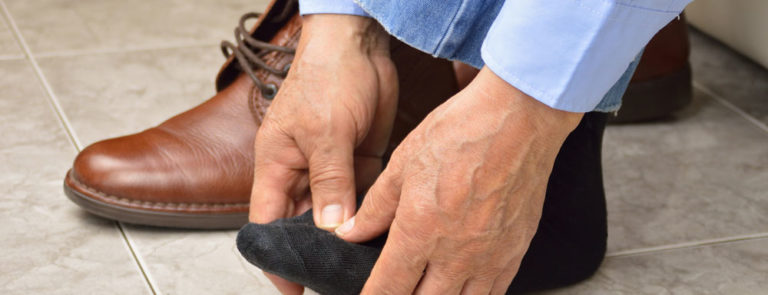15% off £35 OR 20% off £45
Code:FAVES
What is gout?

It's on the rise in the UK but what actually is gout? We share the common causes and symptoms, and also give general advice on how to best manage the pain.
Gout is when you experience sudden or severe attacks of pain usually at the base of your big toe but can happen in other joints too, as well as swelling, redness and tenderness. The pain often occurs suddenly, and people have reported a sensation of the affected joint being on fire.
Gout is on the rise in the UK – read our article to find out everything you need to know about gout and how your lifestyle can actually increase your risk of developing the old-fashioned ailment, making a modern comeback. Yes, gout may sound like a Victorian joke but it’s no laughing matter, as it can cause excruciating joint pain.1 There’s been a dramatic increase in the number of cases over the past 20 years, with around one in 40 adults in the UK now affected.2
So, what is gout, why has there been a rise and could you be at risk? All this covered and more below:
What is gout?
Gout is a type of arthritis in which small crystals form in and around the joints, causing severe pain and inflammation.3 At first, it may affect just one joint – often your big toe – but over time it can affect other joints such as ankles, knees, elbows and wrists.4
9 interesting facts about gout
- More men are affected by gout than women
- Gout is a genetic disease
- 90% of people with gout have kidneys issues
- 10% of people who suffer with gout make too much uric acid in their system
- 90% of gout attacks happen at a single joint (often the big toe)
- It is estimated that between one and two in every 100 people in the UK have gout
- 8.3 million people in the US have gout
- Gout is progressive, with attacks becoming worse and more frequent
- Pain and discomfort from gout is manageable in most people25,26
What are some common symptoms of gout?
Gout often appears without any warning, and symptoms can develop over a few hours.5
You may experience:
- sudden excruciating joint pain, usually at night, which gets worse over 12 to 24 hours before easing off 6
- red, hot, swollen skin surrounding the affected joint that’s too sore to touch7
- peeling, flaky skin when the swelling goes down8
- an attack may last for one or two weeks if it’s not treated, and your symptoms may come back every few weeks or months.9
What is the main cause of gout?
Gout is caused by too much uric acid in the body. Your body produces it naturally, but uric acid is also formed when your digestion breaks down chemicals called purines.10 Your uric acid levels depend on:11
- the amount of purines in your diet
- how much uric acid your body makes
- how quickly your kidneys remove uric acid from your body
However, not everyone with high levels of uric acid gets gout – and doctors don’t yet know why.13
What does gout look like?
Here are a few images of what to look out for: gout on hands and fingers and gout on foot.


Gout can look different depending on the person, however, there will always be similar characteristics.


How you can help prevent gout
Making certain lifestyle changes can both help manage your symptoms and prevent future attacks by lowering levels of uric acid. These include:
- Eating a healthy diet – a 2017 study in the British Medical Journal found that people eating plenty of vegetables, fruit and wholegrains were less likely to get gout.17
- Avoiding foods rich in purines – this includes red meat, offal, seafood such as sardines, herring or anchovies, and foods that contain yeast extract.18
- Cutting down on sugary foods and drinks – fructose can cause a build-up of uric acid in the body.19
- Maintaining a healthy weight – losing weight can significantly reduce the amount of uric acid your body produces.20
- Drinking sensibly – this involves drinking plenty of water, as dehydration can make gout worse, and avoiding excess alcohol, especially beer and spirits as they’ve been linked to more frequent attacks.22
- Make any positive, healthy lifestyle change - make any positive ‘healthy’ lifestyle you can eg stopping smoking and doing more regular exercise
- Limiting the following foods - limit specific foods that are linked to gout including meat and seafood, fruit juices that are naturally sweet, and other foods such as sugar, desserts and salts.27
What is the best thing to drink if you have gout?
This is a common question and current guidelines recommend drinking plenty of water and staying hydrated. As already stated above, drinking too much alcohol can increase the risk of developing gout, make sure you don’t exceed the recommended weekly allowance which is 14 units in the UK.28
Diagnosing and treating gout
If you suspect that you have gout, make an appointment with your doctor or GP. They will assess your symptoms and run the necessary examinations, X-rays and lab tests. They will check for signs eg if uric acid crystals are found in the affected joint, this is a sign that you have gout. Important - make an appointment as soon as possible as gout can only be diagnosed during a flare up and when the joint is hot, swollen and painful.
Advice is for information only and should not replace medical care. Please check with your GP before trying any remedies.
Last updated: 20 November 2020
Sources
1. Versus Arthritis. What is gout? https://www.versusarthritis.org/about-arthritis/conditions/gout/
2. Kuo CF, et al. Rising burden of gout in the UK but continuing suboptimal management: a nationwide population study https://www.ncbi.nlm.nih.gov/pmc/articles/PMC4392307/
3. Abhishek A, et al. Gout – a guide for the general and acute physicians https://www.ncbi.nlm.nih.gov/pmc/articles/PMC6297580/
4. N. Lawrence Edwards. Gout. The MSD Manual https://www.msdmanuals.com/en-gb/professional/musculoskeletal-and-connective-tissue-disorders/crystal-induced-arthritides/gout
5. UK Gout Society. All about gout https://www.msdmanuals.com/en-gb/professional/musculoskeletal-and-connective-tissue-disorders/crystal-induced-arthritides/gout
6. As Source 1
7. NHS Inform. Gout https://www.nhsinform.scot/illnesses-and-conditions/muscle-bone-and-joints/conditions/gout#symptoms-of-gout
8. As above
9. As Source 5
10. As Source 1
11. Medscape. Gout and pseudogout overview https://emedicine.medscape.com/article/329958-overview#showall?form=fpf
12. As Source 5
13. As Source 7
17. Science Daily. Diet rich in fruit, vegetables and whole grains may lower risk of gout https://www.sciencedaily.com/releases/2017/05/170509192118.htm
18. As Source 7
19. Jamnik J, et al. Fructose intake and risk of gout and hyperuricemia: a systematic review and meta-analysis of prospective cohort studies https://www.ncbi.nlm.nih.gov/pmc/articles/PMC5073537/
20. As Source 1
21. Juraschek SP, Miller ER 3rd, Gelber AC. Effect of oral vitamin C supplementation on serum uric acid: a meta-analysis of randomized controlled trials https://www.ncbi.nlm.nih.gov/pmc/articles/PMC3169708/
22. As Source 1
23. Bell PG, et al. Montmorency tart cherry (Prunus cerasus L.) concentrate lowers uric acid, independent of plasma cyanidin-3-O-glucosiderutinoside https://www.sciencedirect.com/science/article/abs/pii/S1756464614002886
24. As Source 7
Related Articles
Shop by wellness goal
Sign up for exclusive offers
Plus, get expert advice to support your health & wellness straight to your inbox when you sign up to Holland & Barrett emails.
Read our
privacy policy













